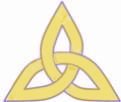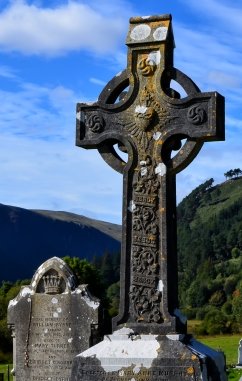- Home ›
- Irish church records ›
- Celtic high crosses
Celtic high crosses
The Celtic High Cross is undoubtedly one of the best known symbols of Ireland.
What distinguishes the high crosses is that they are ornamental stones and at least 800 years old. Anything younger than that is not a High Cross but just a generic Irish/Celtic cross.
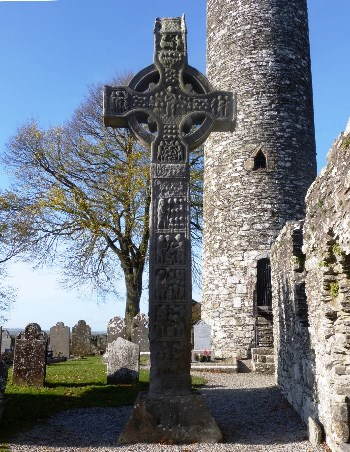 The tallest of the three high crosses at Monasterboice, the Tall or West Cross, stands 6.5m high but is dwarfed by the neighbouring Round Tower
The tallest of the three high crosses at Monasterboice, the Tall or West Cross, stands 6.5m high but is dwarfed by the neighbouring Round Tower The tallest of the three high crosses at Monasterboice, the Tall or West Cross, stands 6.5m high but is dwarfed by the neighbouring Round Tower
The tallest of the three high crosses at Monasterboice, the Tall or West Cross, stands 6.5m high but is dwarfed by the neighbouring Round TowerCut from sandstone or granite, a typical high cross consists of three or four parts starting with the Base.
The shaft, or panel, was slotted into the base. Then came the cross head the arms and ring and finally a capstone, few of which survive.
Sometimes the panel and cross head were cut from one single piece of stone. After erection, the task of carving would begin.
Early examples carried only geometric Irish Celtic symbols and patterns; in the 9th and 10th centuries scenes from the Bible began to be sculpted.
Unlike the ubiquitous Irish Celtic cross gravestone or memorial of the modern age, the ancient High Crosses of Ireland were never intended to mark places of burial. They were constructed as boundary markers of significant territory or sacred land.
As decorative points of interest on the site of monasteries, their carvings were later also used for religious educational purposes. In addition to these lofty purposes, communities held celebrations around their local cross.
Below is my selection of the best Celtic High Crosses in Ireland.
Monasterboice
County Louth has two outstanding Celtic High Crosses within the ruins of this famous religious site (founded in the 6th century) which comes complete with two church ruins, a sundial and a 28m-high round tower.
The churches date from the late 1400s while the round tower is among the earliest in Ireland and thought to date from the late 900s. The site also has an extensive graveyard with headstones dating from the 18th century to the recent present. Many of them feature beautifully-cut inscriptions and religious symbols.
Muiredach's High Cross (below), also called the West Cross, is considered by many to be the very finest of all high crosses in Ireland. Each of its sandstone faces is covered in biblical scenes, both Old and New Testament.
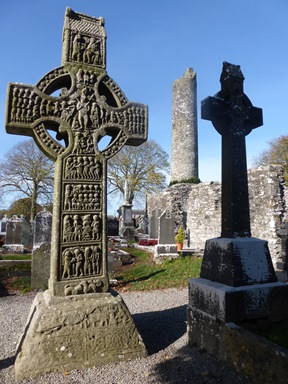 Muiredach's 5.2m High Cross in Monasterboice is smaller than the Tall cross but its carving is exquisite.
Muiredach's 5.2m High Cross in Monasterboice is smaller than the Tall cross but its carving is exquisite.Included are Adam and Eve in the garden, Cain slaying Abel, David and Goliath, the Adoration of the Magi, the Resurrection and the Crucifixion.
The other cross at Monasterboice is the West or Tall Cross, pictured above. Standing 6.5m high, it is believed to be the tallest surviving Celtic High Cross.
Sadly, much of its carving detail has weathered poorly but it is still possible to make out some representations of the Crucifixion.
There is a third high cross at Monasterboice but it is not as impressive as these two.
County Louth has two outstanding Celtic High Crosses within the site of this famous religious site (founded in the early 6th century), which comes complete with two church ruins, a sundial and a 28m-high round tower.
 Muiredach's 5.2m High Cross in Monasterboice is smaller than the Tall cross but its carving is exquisite.
Muiredach's 5.2m High Cross in Monasterboice is smaller than the Tall cross but its carving is exquisite.The churches date from the late 1400s while the round tower is among the earliest in Ireland and thought to date from the late 900s.
The site also has an extensive graveyard with headstones dating from the 18th century to the recent present. Many of them feature beautifully-cut inscriptions and religious symbols.
Monasterboice is also home to Muiredach's High Cross, aka the West Cross, which is widely considered the very finest of all high crosses in Ireland.
Each of its sandstone faces is covered in carvings depicting biblical scenes from both Old and New Testament. Included are Adam and Eve in the garden, Cain slaying Abel, David and Goliath, the Adoration of the Magi, the Resurrection and the Crucifixion.
The other cross at Monasterboice is the West or Tall Cross, pictured above. Standing 6.5m high, it is believed to be the tallest surviving Celtic High Cross.
Sadly, much of its carving detail has weathered poorly but it is still possible to make out some representations of the Crucifixion.
There is a third high cross at Monasterboice but it is not as impressive as these two.
Ahenny
The Celtic High Cross of Moone
The Moone Cross, in County Kildare, is thought to date from the 8th century and is one of the best preserved High Crosses in Ireland.
Perhaps its preservation owes much to its not being discovered until 1835.
More recently a glass roof has been erected above the 5.4m-high cross to protect it from the worst of the weather.
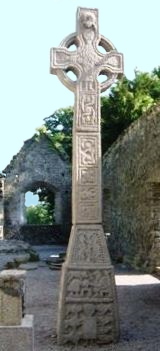
It carries a lot of geometric decoration and other Celtic patterns but it is also rich in biblical carvings. It's possible to make out the 12 apostles standing together in rows on the west face of the base.
On the south face, the Miracle of the Loaves and Fishes is represented by five stone-cut loaves and two fishes, while the other faces show the stories of the Flight into Eygpt, the Fall of Adam and Eve, and Daniel and the Lion.
With their interlaced Celtic patterns and spirals, the sandstone crosses at Ahenny in County Tipperary are typical of 8th-century ornamental crosses. Both feature many Celtic knot patterns. Only the bases have any biblical scenes and they are now difficult to read. The South Cross is 3.9m high. The North Cross is 3.13m high and sports a fetching mitre-shaped capstone.
Ardboe
Located on the shore of Lough Neagh in County Tyrone, this 5.6m-high cross is showing its age. Dating from the 10th century, it has lost part of its ring and its east face is badly weathered. On the west face, biblical scenes such as the Adoration of the Magi, the arrest of Christ, and the wedding of Canna are depicted and some of these carvings remain quite clear.
This Celtic High Cross is the tallest in Northern Ireland and the third tallest on the island.
Drumcliffe
In Sligo, in the graveyard where the poet W B Yeats is buried, stands a superb example of a richly carved Celtic High Cross. Typical Celtic cross art adorns almost every inch of the stone: spirals, geometric patterns, animal figures (including a camel), as well as biblical scenes. It is thought to date from the 9th century.
Graignamanagh
Two of Ireland's oldest granite high crosses are in the graveyard of Duiske Abbey in County Kilkenny. Dating from the 8th century, they pre-date the Abbey and were brought here from sites nearby.
The North Cross has arms that do not extend through the ring - an indicataion of its antiquity.
The South Cross is similar but a little dumpy in its proportions.
Kilkieran
Also in County Tipperary, and only a few miles from Ahenny, are three more Celtic high crosses. They date from the 9th century.
One - the Plain Cross - has no carved ornament but retains its capstone.
The Long Shaft Cross is what you might expect from its name: a long panel with short arms. The West Cross is a weathered example of a richly carved cross.
Clonmacnoise
The Cross of the Scriptures is arguably the most photographed of all the Irish high crosses, partly because it stands on Ireland's most important monastic site in County Offaly where the Kings of Connacht and of Tara were buried.
It is highly decorated with biblical scenes, including the Last Judgement and the Crucifixion, but the identity of many of the carved characters are difficult to establish due to the weathering of the stone.
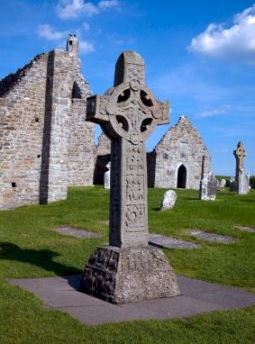 The Cross of the Scriptures, Clonmacnoise
The Cross of the Scriptures, ClonmacnoiseThere are two other high crosses on the site, but the originals of all three were moved into the museum section of the Visitors' Centre in the early 1990s. Very convincing replicas now stand on the original spots.
Clonmacnoise was founded in 544 by St. Ciarán from County Roscommon. Its strategic location beside the river Shannon led to it becoming a major centre for learning, skilled crafts, especially in metal and stone work, and trade. Visited by scholars from across Europe, it grew to a monastic and educational community of up to 2,000 men, supported by a secular community close by.
It began to decline in the 12th century and in 1552 was looted and left in ruins by the English.
The Cross of the Scriptures is arguably the most photographed of all the Irish high crosses, partly because it stands on Ireland's most important monastic site in County Offaly where the Kings of Connacht and of Tara were buried.
 The Cross of the Scriptures, Clonmacnoise
The Cross of the Scriptures, ClonmacnoiseIt is highly decorated with biblical scenes, including the Last Judgement and the Crucifixion, but the identity of many of the carved characters are difficult to establish due to the weathering of the stone.
There are two other high crosses on the site, but the originals of all three were moved into the museum section of the Visitors' Centre in the early 1990s. Very convincing replicas now stand on the original spots.
Clonmacnoise was founded in 544 by St. Ciarán from County Roscommon. Its strategic location beside the river Shannon led to it becoming a major centre for learning, skilled crafts, especially in metal and stone work, and trade. Visited by scholars from across Europe, it grew to a monastic and educational community of up to 2,000 men, supported by a secular community close by.
It began to decline in the 12th century and in 1552 was looted and left in ruins by the English.
Moone
The Moone Cross, in County Kildare, is thought to date from the 8th century and is one of the best preserved High Crosses in Ireland.
Perhaps its preservation owes much to its not being discovered until 1835.
More recently a glass roof has been erected above the 5.4m-high cross to protect it from the worst of the weather.
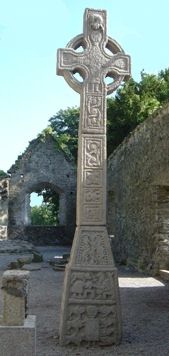 Moone High Cross, Co Kildare
Moone High Cross, Co KildareIt carries a lot of geometric decoration and other Celtic patterns but it is also rich in biblical carvings. It's possible to make out the 12 apostles standing together in rows on the west face of the base.
On the south face, the Miracle of the Loaves and Fishes is represented by five stone-cut loaves and two fishes, while the other faces show the stories of the Flight into Eygpt, the Fall of Adam and Eve, and Daniel and the Lion.
